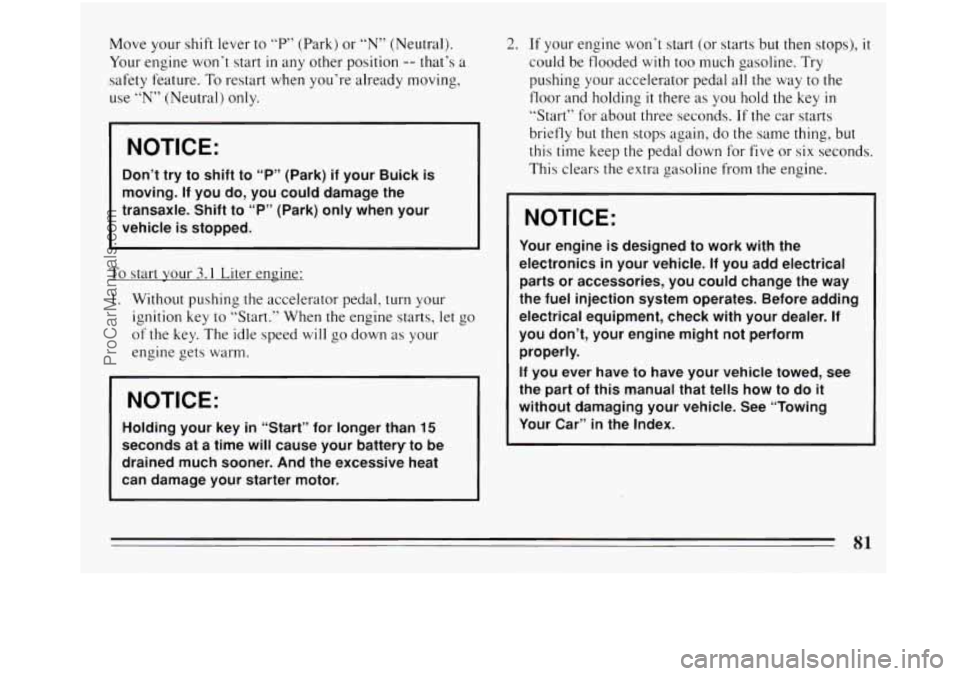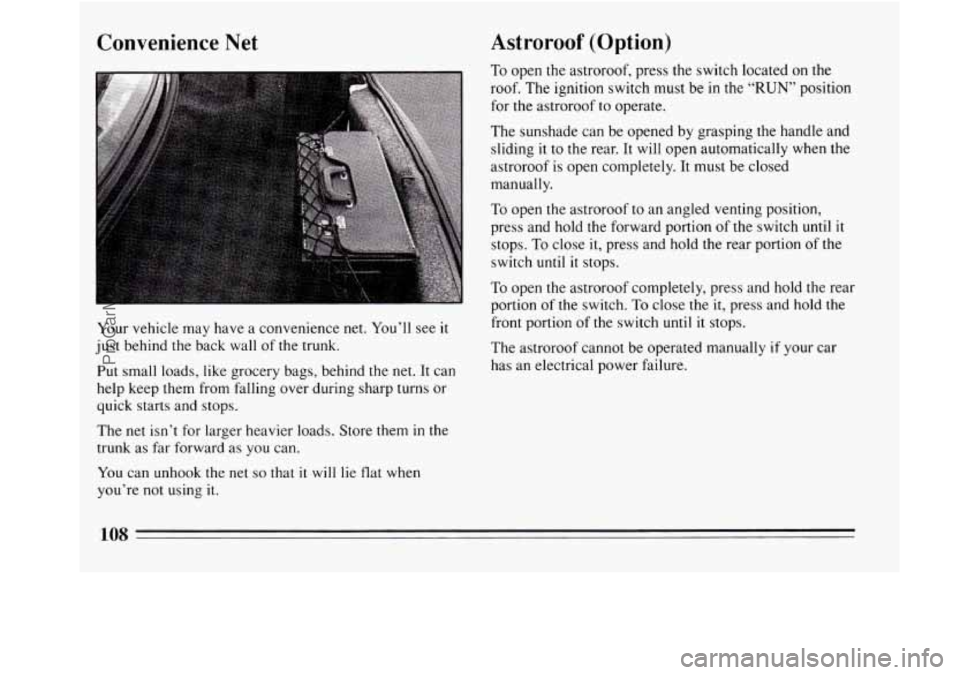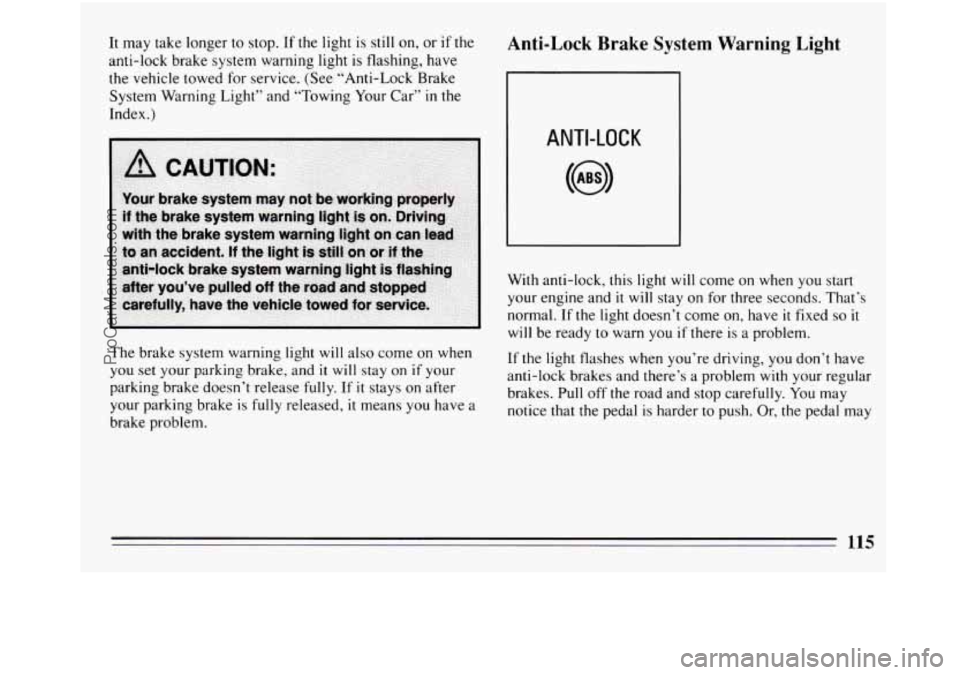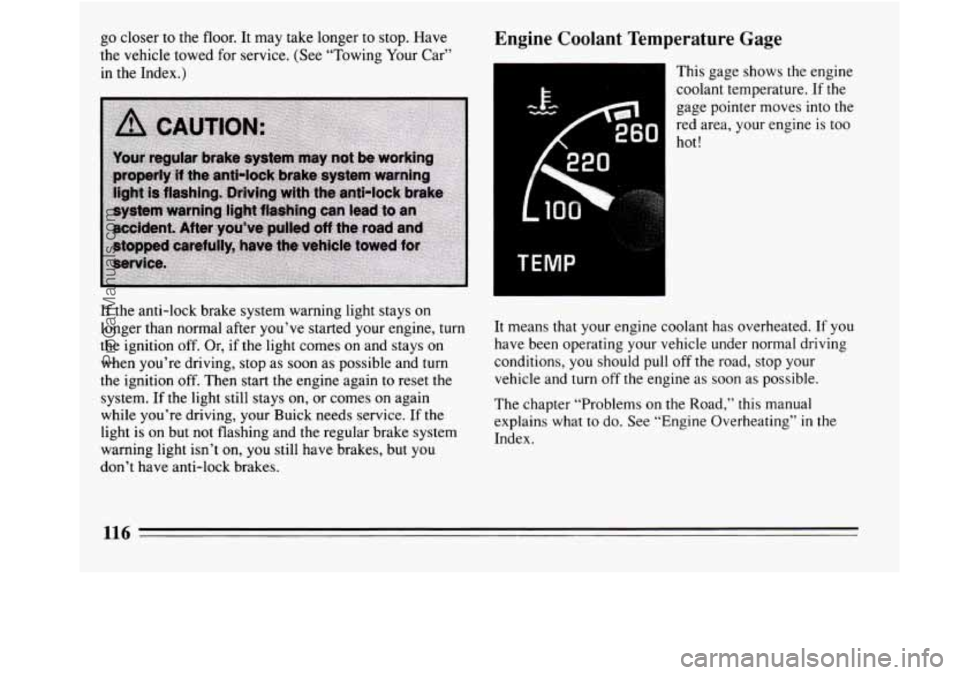Page 81 of 308
New Vehicle “Break-InSS
NOTICE:
Your modern Buick doesn’t need an elaborate
“break-in.” But it will perform better
in the long
run if you follow these guidelines:
Don’t drive at any one speed -- fast or slow
-- for the first 500 miles (804 km). Don’t
make full-throttle starts.
Avoid making hard stops for the first 200
miles (322 km) or so. During this time your
new brake linings aren’t yet broken
in. Hard
stops with new linings can mean premature
wear and earlier replacement. Follow this
“breaking-in” guideline every time you get
new brake linings.
Ignition Key Positions
Your key with the black
plastic
head operates your
ignition lock.
79
ProCarManuals.com
Page 83 of 308

Move your shift lever to “P” (Park) or “N” (Neutral).
Your engine won’t start
in any other position -- that’s a
safety feature. To restart when you’re already moving,
use
“N” (Neutral) only.
NOTICE:
--
Don’t try to shift to “P” (Park) if your Buick is
moving. If you do, you could damage the
transaxle. Shift to “P” (Park) only when your
vehicle
is stopped.
To start your 3.1 Liter engine:
1. Without pushing the accelerator pedal, turn your
ignition key
to “Start.” When the engine starts, let go
of the key. The idle speed will go down as your
engine gets warm.
NOTICE:
Holding your key in “Start” for longer than 15
seconds at a time will cause your battery to be
drained much sooner. And the excessive heat
can damage your starter motor.
2. If your engine won’t start (or starts but then stops), it
could be flooded with too much gasoline. Try
pushing your accelerator pedal all the way to the
floor and holding
it there as you hold the key in
“Start” for about three seconds. If the car starts
briefly but then stops again, do the same thing, but
this time keep the pedal down for five or six seconds.
This clears the extra gasoline from the engine.
NOTICE:
Your engine is designed to work with the
electronics
in your vehicle. If you add electrical
parts
or accessories, you could change the way
the fuel injection system operates. Before adding
electrical equipment, check with your dealer. If
you don’t, your engine might not perform
properly.
If you ever have to have your vehicle towed, see
the part of this manual that tells how to do it
without damaging your vehicle. See “Towing
Your Car” in the Index.
81
ProCarManuals.com
Page 86 of 308
Automatic Transaxle
There are several different positions for your shift lever.
0 P (Park)
This lacks your front wheels. It's the best position to
use when you start your engine because your vehicle
can't move easily.
0 R (Reverse)
Use this gear to back up.
NOTICE:
Shifting to "R" (Reverse) while your vehicle is
moving forward could damage your transaxle.
Shift
to "R" only after your vehicle is stopped.
84
ProCarManuals.com
Page 99 of 308

For a single wiping cycle, turn the band to “MIST.”
Hold
it there until the wipers start, then let go. The
wipers
will stop after one cycle. If you want more
cycles, hold the band on “MIST” longer.
You can set the wiper speed for a long or short delay
between wipes. This can be very useful
in light rain or
snow. Turn the band to choose the delay time. The
closer to
“LO,” the shorter the delay.
For steady wiping at low speed, turn the band away
from you to the
“LO” position. For high speed wiping,
turn the band further, to “HI.” To stop the wipers, move
the band to “OFF.”
Remember that damaged wiper blades may prevent you
from seeing well enough to drive safely. To avoid
damage, be sure to clear ice and snow from the wiper
blades before using them. If they‘re frozen to the
windshield, carefully loosen or thaw them. If your
blades do become damaged, get new blades or blade
inserts.
Heavy snow or ice can overload your wiper motor.
A
circuit breaker will stop the motor until it cools. Clear
away snow or ice to prevent an overload.
Windshield Washer
At the top of the turn signal/headlight beam lever there’s
a paddle
with the word “PUSH” on it. To spray washer
fluid on the windshield, push the paddle. Unless they are
already turned on, the wipers will operate at low speed
for several sweeps, then
turn off.
Driving without washer fluid can be dangerous.
A bad
mud splash can block your vision. You could
hit another
vehicle or
go off the road. Check your washer fluid level
often.
A CAUTION:
In freezing weather, don’t use your washer until
the windshield
is warmed. Otherwise the washer
fluid can form ice on the windshield, blocking
your vision.
97
ProCarManuals.com
Page 110 of 308

Convenience Net
Your vehicle may have a convenience net. You’ll see it
just behind the back wall of the trunk.
Put small loads, like grocery bags, behind the net. It can
help keep them from falling over during sharp turns or
quick starts and stops.
The net isn’t for larger heavier loads. Store them
in the
trunk as far forward as you can.
You can unhook the net
so that it will lie flat when
you’re not using
it.
Astroroof (Option)
To open the astroroof, press the switch located on the
roof. The ignition switch must be in the
“RUN” position
for the astroroof
t.o operate.
The sunshade can be opened by grasping the handle and
sliding it to the rear. It
will open automatically when the
astroroof is open completely. It must be closed
manually.
To open the astroroof to an angled venting position,
press and hold the forward portion of the switch until it
stops. To close it, press and hold the rear portion
of the
switch
until it stops.
To open the astroroof completely, press and hold the rear
portion of the switch. To close the
it, press and hold the
front portion of
the switch until it stops.
The astroroof cannot be operated manually if your car
has an electrical power failure.
108
ProCarManuals.com
Page 116 of 308
* LOW
FUEL
L
When your fuel gage reads in the red band, this light will
go on. You should get
more fuel
as soon as you
can.
Brake System Warning Light
BRAKE
Your Buick’s hydraulic
brake system is divided into
two parts. If one part isn’t
working, the other
part can
still work and stop you..For
good braking, though, you
need both parts working
well.
If the warning light comes on, there could be
a brake
problem. Have your brake system inspected right away.
This light should come on as you start the vehicle.
If it
doesn’t come on then, have it fixed
so it will be ready to
warn you if there’s a problem.
If the light comes
on while you are driving, pull off the
road and stop carefully. You may notice that the pedal is
harder to push. Or, the pedal may
go closer to the floor.
114
ProCarManuals.com
Page 117 of 308

It may take longer to stop. If the light is still on, or if the
anti-lock brake system warning light is flashing, have
the vehicle towed for service. (See “Anti-Lock Brake
System Warning Light” and “Towing Your Car” in the
Index.)
The brake system warning light will also come on when
you
set your parking brake, and it will stay on if your
parking brake doesn’t release
fully. If it stays on after
your parking brake is
fully released, it means you have a
brake problem.
Anti-Lock Brake System Warning Light
ANTI-LOCK
With anti-lock, this light will come on when you start
your engine and
it will stay on for three seconds. That’s
normal. If the light doesn’t come on, have
it fixed so it
will be ready to warn you if there is a problem.
If the light flashes when you’re driving, you don’t have
anti-lock brakes and there’s a problem with your regular
brakes. Pull
off the road and stop carefully. You may
notice that the pedal is harder to push. Or, the pedal may
115
ProCarManuals.com
Page 118 of 308

go closer to the floor. It may take longer to stop. Have
the vehicle towed for service. (See “Towing Your Car”
in the Index.) Engine Coolant Temperature Gage
This gage shows the engine
coolant temperature. If the
gage pointer moves into the
red area, your engine
is too
hot!
If the anti-lock brake system warning light stays on
longer than normal after you’ve started your engine, turn
the ignition off. Or,
if the light comes on and stays on
when you’re driving, stop as soon as possible and turn
the ignition off. Then start the engine again to reset the
system. If the light still stays on, or comes on again
while you’re driving, your Buick needs service. If the
light is on but not flashing and the regular brake system
warning light isn’t on,
you still have brakes, but you
don’t have anti-lock brakes. It means
that your engine coolant has overheated. If you
have been operating your vehicle under normal driving
conditions,
you should pull off the road, stop your
vehicle and turn off the engine as soon as possible.
The chapter “Problems on the Road,” this manual
explains what to do. See “Engine Overheating”
in the
Index.
116
ProCarManuals.com